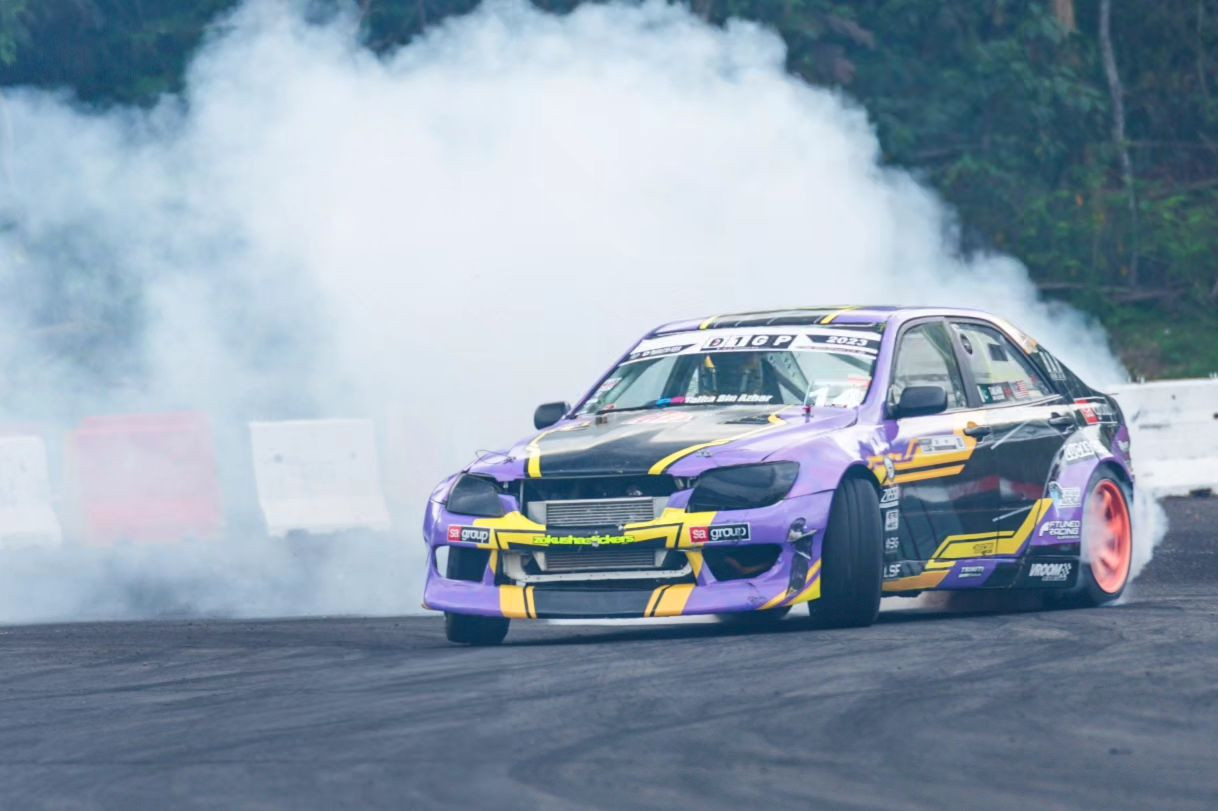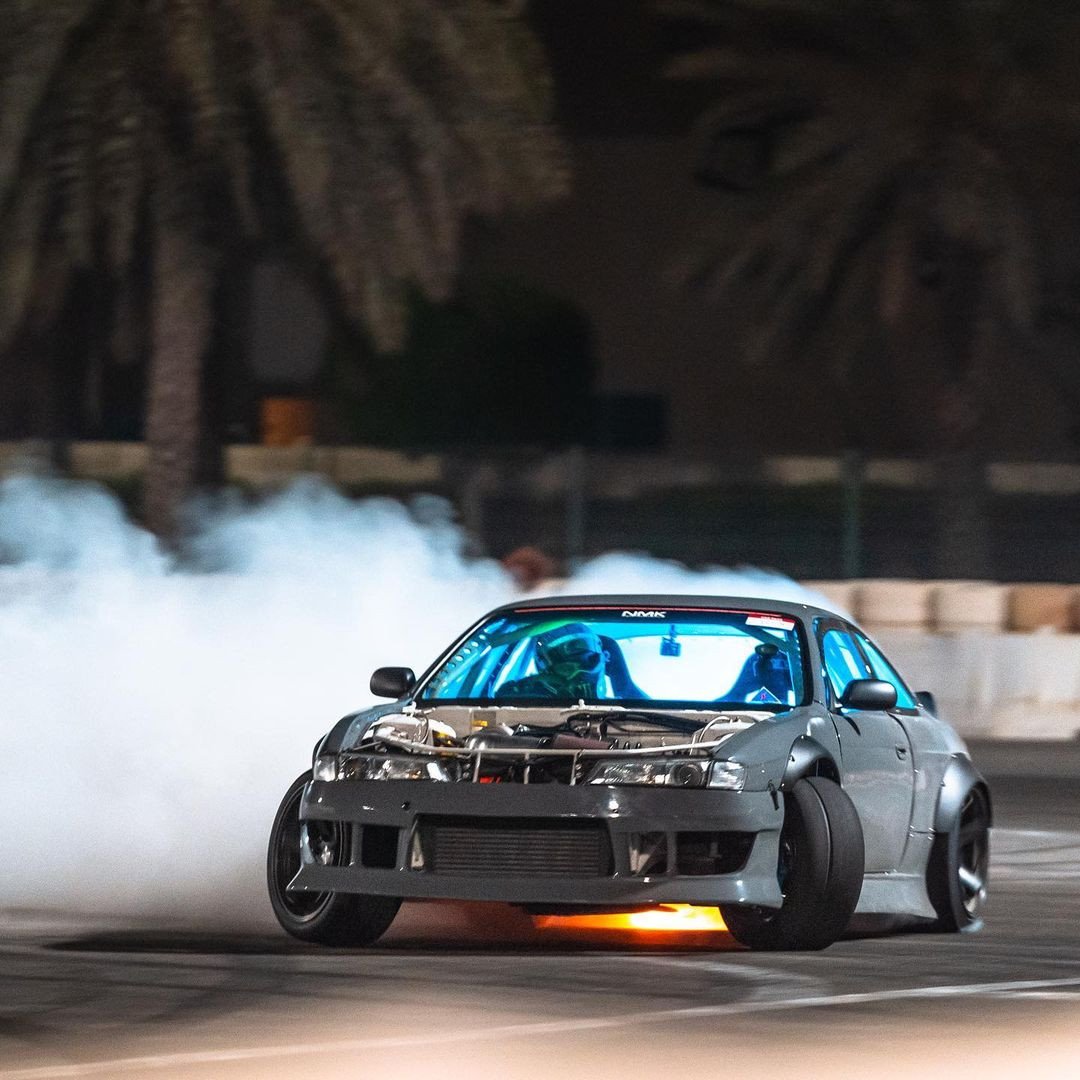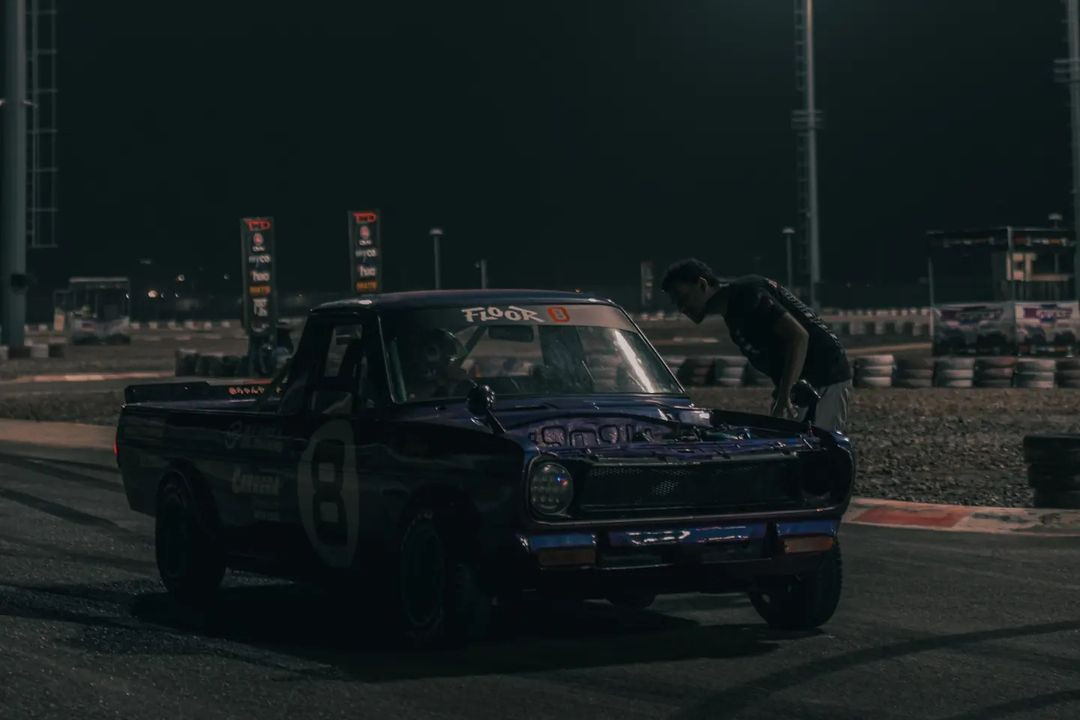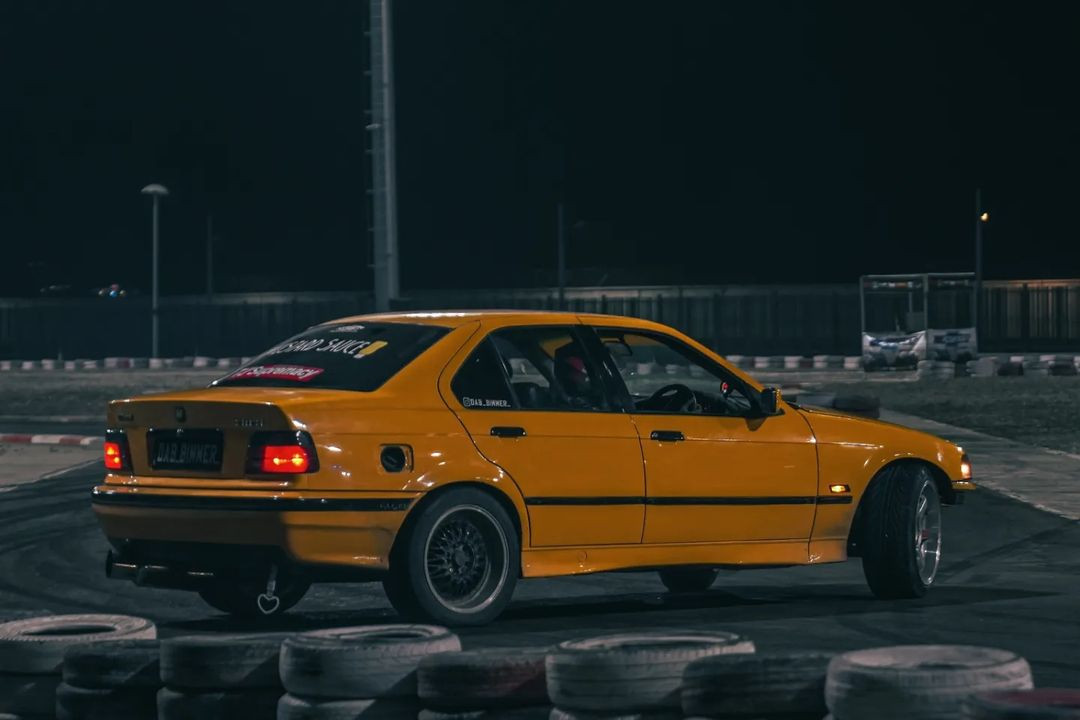The air is electric, the smell of burning rubber hangs heavy, and the roar of revving engines reverberates through the stands. On the Vroom Racing Circuit, the thrill of drift racing has taken hold, captivating a new generation of motorsport enthusiasts. As the Nissan Silvia S15 glides effortlessly through hairpin turns, its tires screeching in protest, the crowd holds its collective breath. This is drifting, Pakistan-style – a symphony of speed, style, and precision, where drivers push the limits of their machines and themselves.
What was once a clandestine activity, relegated to the city's back alleys and deserted streets, has evolved into a full-fledged phenomenon. Drift racing has emerged from the shadows, finding a new home on purpose-built tracks like Vroom, where safety meets adrenaline. The transformation is striking, organized events, professional drivers, and a sense of community that's drawing in fans from across the country.
As the sport continues its meteoric rise in popularity, we delve into the world of Pakistani drift racing, exploring the drivers, tracks, and culture that define this high-octane pursuit. From Lahore to Karachi, the growth of this exhilarating sport, and what its newfound legitimacy means for the enthusiasts who've spent years perfecting the art of the drift.
For Talha Bin Azhar, a pioneer in Pakistan's drift racing scene, the journey has been nothing short of remarkable. "Drifting in Pakistan has been a very sensitive topic," he recounts, reflecting on the sport's tumultuous past. But Talha's determination has been instrumental in shifting the narrative. Inspired by a friend, he embarked on a mission to legitimise drift racing, promoting track events while discouraging the reckless street drifting that once plagued the sport.
"We started with just three cars, and it hasn't been an easy journey," Talha admits. "It's been difficult and full of obstacles, but we've overcome them." Perseverance paid off in 2022, when a successful drift event in Karachi marked a turning point for the community. "That's when it transformed from a hobby into an industry," Talha says, beaming with pride.
Today, Talha's vision of a safe and regulated drifting environment is a reality. As the sport continues to gain momentum, his message remains clear; "We want to spread awareness and promote track drifting, while discouraging street drifting." The results are evident, a thriving community, world-class events, and a new generation of drivers pushing the limits of speed and style.

From underground to mainstream
Drifting in Pakistan has undergone a remarkable transformation, evolving from the shadows of underground street racing to the spotlight of organized motorsport. A decade ago, enthusiasts gathered in parking lots and back alleys, where the roar of modified engines echoed through urban streets. The thrill of tires screeching and smoke billowing was a clandestine affair, known mostly to a select few.
In little over two years, Pakistan's drifting scene has transformed from an underground phenomenon to a thriving motorsport, captivating enthusiasts nationwide. At the forefront of this revolution are pioneers like Talha, Adeel Yaqoob, Rohab Khan, and, Fahad Agha who've witnessed the sport's meteoric rise.
"From being one of the only drifters to seeing a whole community form in just under a couple years is actually mind-blowing," says Rohab, a seasoned drifter. This sentiment is echoed by Adeel, who notes, "The drifting scene has come a long way, starting from small, informal events to now having dedicated competitions like Drift Matsuri. The community has grown, with more enthusiasts building their cars and organizing events." The turning point came in 2021 when Talha, organizer of Drift Matsuri Pakistan, and his team began hosting events.
Social media has played a pivotal role in popularizing drifting in Pakistan. "Social media is the main source of making drifting so well known in not just Pakistan but all over the world," Rohab asserts. Fahad, who joined the community two years ago, adds, "Social media has enabled people to learn new skills with way less effort compared to before. Now, to learn some new information, you just have to watch a short video.”
He adds that drifting fell victim to two different perceptions, that it's a public nuisance and that it's only for the elite. “But social media has helped change that narrative, showcasing local talent and events, and inspiring more people to get involved in the sport,” said Fahad.
Adeel concurs, "Social media has been a game-changer. These platforms allow us to showcase local talent and events, bringing global attention and inspiring more people to get involved in the sport." The impact is evident, with events like Drift Matsuri and DriftFest drawing in thousands of spectators and dozens of participants.
"Drift Matsuri was the biggest and longest layout ever done since the beginning," Talha proudly states. "This time, there were 45 racers from all over Pakistan on event date. Many of them have joined over the years as the scene has evolved and getting inspired by the drivers, team, and brand."
The community's growth is staggering. "We've grown from 20 drift-worthy cars and 25-30 donut-capable vehicles to 41 fully-equipped cars," Talha says. Rohab notes, "There's a lot of awareness, and this sport is actually growing from being called an illegal activity to being accepted as a sport that it is known as worldwide." Adeel adds, "The biggest difference is the professionalism. When we first started, it was just a group of enthusiasts. Now, there are organized events and a real sense of community with people investing in cars and gear."
As Pakistan's drift scene continues to thrive, enthusiasts are eager to take it to the next level. Talha envisions a future where Pakistani drivers compete internationally, making a strong impression. "What sets us apart is introducing solo and tandem drifting simultaneously. We have around 8-10 cars and drivers capable of competing in tandem battles. Pit them against each other, and it'll be an unforgettable experience."

Overcoming obstacles
As Pakistan's drift scene continues to gain momentum, enthusiasts face significant challenges that threaten to hinder the sport's growth. Lack of infrastructure, limited government support, and high costs for participants are major concerns.
"The lack of proper infrastructure is a major challenge," Adeel explains. "Dedicated tracks are scarce, and the high cost of maintaining and modifying drift cars without sponsors can make it tough. Regulations regarding motorsports are also limited, which can slow down progress." Fahad concurs, "In my opinion, the biggest obstacle drifters face is the lack of racetracks. Pakistan needs more racetracks so that drivers have a platform to improve their skills and learn in a controlled environment rather than doing it on the streets."
Rohab echoes this sentiment, "As of now, I believe the major things holding this sport back is the lack of infrastructure. If we had more circuits around Pakistan, this would actually bring this sport to the next level." The scarcity of proper racetracks forces some drivers to practice in unsafe or illegal environments, undermining the sport's legitimacy. "Most people are willing to fund it already," Rohab notes, "But we need more circuits."
Talha emphasizes the importance of preserving the community's integrity while addressing these challenges. "Our focus should be on scaling progress while preserving the community's integrity. Our goal is to keep drifting impartial, unbiased, and politics-free. No city politics, no agendas." He advocates for involvement from the FIA-sanctioned body, the ASN, to establish standardized sporting regulations. "Once we have a solid foundation, we can develop drivers as athletes, and workshops can focus on building safe, high-quality drift cars with roll cages," he adds.
Financial constraints also weigh heavily on drivers. "Drifting is a sport that has a lot of operating costs," Fahad notes. "In a competitive environment, private sectors can help support drivers that need the help to pursue their passion and have the potential to be the best driver in the community." Adeel suggests, "The government can help by recognizing motorsports officially, creating more dedicated tracks, and facilitating events. Private sector sponsorships are also key to providing financial support to drivers and event organizers."
Haris Khan whose favorite drift car is the E36 coupe, shares his passion for drifting: "It is a proven chassis with tons of aftermarket support." When asked about modifying his vehicle for drifting, he emphasizes, "Putting more powerful engine in the car is the first step in my POV, rest of the upgrades just help the driver get better."
To overcome these obstacles, experts propose a multi-faceted approach. Talha envisions a future where "we can develop drivers as athletes, and workshops can focus on building safe, high-quality drift cars with roll cages. This will unlock a cycle of business ventures, marketing, and growth." Rohab stresses, "If the government can provide proper circuits and allot proper places for these events to take place, I think that's all we need." Fahad adds, "Government sectors can help make more tracks for the drivers."
Adeel highlights the importance of a dedicated asphalt circuit, "A track with long sweeping corners and hairpins would be ideal… more tracks designed specifically for drifting would take the sport to the next level." Rohab concurs, "Asphalt should be the only terrain for drifting."
Addressing infrastructure and financial challenges will be crucial to the success of evolving drifting scenes. By bringing the international standards here in the country will lift the motorsports culture all together.

Potential for growth
To match international standards, Pakistani drivers must gain firsthand experience in global competitions, honing their skills alongside the world's best. This crucial step will bridge the gap between local talent and international excellence
"Collaborations with international drifters and attending global competitions can provide valuable learning opportunities," Adeel emphasizes. "Drifting in Pakistan could benefit from exchange programs and partnerships with global drift teams." Fahad concurs, "Currently, there are no such opportunities or collaborations, but I'm sure that there are definitely drivers present in the community that would accomplish wonders if they were given the opportunity."
The ultimate goal is to send Pakistani drivers to prestigious international events. "Events like Formula Drift or D1 Grand Prix are at the top of the list," Adeel says. "If we can send our drivers there, it would be a huge step for the scene." Haris Khan shares his aspirations, "I would like to see us competing in Formula DRIFT and Drift Masters." Rohab expands on this, "We would like to see Pakistani drivers compete in Oman International Drift Competition, Emirates Drift Championship, Drift Masters, National Drift Series, and others. Even make our own events to create a channel between the other Middle East countries."
Participating in global competitions not only boosts Pakistan's drift scene but also opens doors for motorsports tourism. Rohab notes, "If we can show the potential of our circuits and events, I think our country is capable of bringing in a lot of international interests here, which will benefit not only the drivers but also the whole country." Adeel adds, "Local competitions could attract international participants, boosting motorsports tourism in Pakistan. This would be a win-win situation for everyone involved."
To achieve this, Pakistani drivers must develop their skills and gain exposure. Fahad stresses, "Everyone in the community nowadays is buying rear-wheel-drive cars for drifting." Haris Khan observes, "Drifting has become the next big thing towards which the entire community is now shifting." With dedication and perseverance, Pakistani drivers can make a name for themselves globally.
As Pakistan's drift scene continues to evolve, the potential for international recognition and growth is undeniable. With determination and hard work, Pakistani drivers will make their mark on the global drifting stage.
 Drift culture and lifestyle
Drift culture and lifestyle
Drifting transcends the realm of motorsport, embracing a vibrant culture that permeates every aspect of its enthusiasts' lives. For the car enthusiasts, drifting is more than just a thrill, it's a lifestyle that influences fashion, music, and everyday choices.
"Drifting has a huge influence on lifestyle," Adeel explains. "From wearing motorsport apparel to music choices like electronic, rock, and even hip-hop, which are often associated with car culture." This cultural fusion is palpable, with international influences shaping car modifications, fashion trends, and the overall aesthetic of the drift scene.
Fahad notes, "Drifting is a spectator sport. It provides a platform to spark excitement for its spectators." This shared excitement fosters a strong sense of camaraderie within the community. Haris Khan emphasizes, "Our drivers would need to get on a level to compete internationally. This would also require help from our government, but I believe that this is going to be the only way to get sponsors or brand deals." The pursuit of excellence unites drifters, driving collaboration and innovation.
Haris Khan shares his passion for drifting, "Drifting has a big influence on my lifestyle. I hang out with relative people and build cars, I wear relative clothes and listen to relative music."
Rohab highlights the global connections within the drift community. "Drivers outside of Pakistan are sponsored by merchandising brands, energy drinks, etc., and that ultimately grooms them to not just promote the brand but also accept it as their own." This symbiotic relationship between drivers and brands fuels the growth of drift culture.
Music plays a significant role in shaping the drift lifestyle. Adeel mentions, "Electronic, rock, and hip-hop are often associated with car culture." Haris Khan adds, "Drifting has become the next big thing towards which the entire community is now shifting." The high-energy atmosphere of drift events is often accompanied by pulsating music, amplifying the adrenaline rush.
Fashion is another aspect where drift culture makes its mark. Adeel notes, "Motorsport apparel is a big part of the lifestyle." Rohab agrees, "Drivers... are sponsored by merchandising brands... that ultimately grooms them to accept it as their own." The distinctive style of drifters – bold, edgy, and performance-driven – reflects their passion for the sport.
Beyond fashion and music, drifting influences everyday choices. Haris Khan shares, "Personally, I don't think there's a better track than Vroom in Pakistan for drifting." Adeel emphasizes, "Safety comes first, so having proper gear like helmets, roll cages, and fireproof suits is essential to minimize risks while pushing the limits." The emphasis on safety and performance shapes the way drifters approach their craft.

A bright horizon
Building on the progress made, the next five years promise to be transformative. With more infrastructure, support, and international exposure, Pakistan could emerge as a regional hub for drifting, with drivers competing at international levels and possibly hosting international events.
"In the next five years, I see more professional events, better infrastructure, and a larger community," Adeel predicts. "We could even have Pakistani drivers competing on an international level." Fahad concurs, "Observing the current pace of growth. In the next five years, we could be looking at a fleet of drivers from Pakistan that are capable of competing against the best in the world." Rohab envisions a future where "people from other countries coming in to take classes and take part in competitions and events all around our country."
Talha is confident about the scene's potential. "The drift scene in Pakistan is arguably the fastest-growing motorsport scene. The future looks bright for drifting and motorsports in general." He announces an exciting development; "Come November, we're launching the country's first-ever competition format, mirroring international standards."
To sustain this growth, Adeel emphasizes, "Sponsorships and professional team structures will be key. If brands see value in the sport, they can fund drivers, which could make it a viable career." Rohab adds, "Not just Pakistani drivers, but I see this sport being profitable for brands, companies, and individuals that would like to promote their business and products."
With continued support and infrastructure development, Pakistan could emerge as a regional hub for drifting. Talha’s vision is to create a sustainable, thriving drifting scene for future generations. Adeel sees Pakistani drivers competing internationally, while Fahad predicts a fleet of talented drivers capable of global competition.
Rohab's forecast is equally optimistic, "Drifting can become a new earning sector for Pakistan." As the scene expands, it will attract international attention, fostering tourism and economic growth.
As Pakistan's drift scene continues to evolve, one thing is certain the future looks bright. With dedication, passion, and a clear vision, the country is poised to become a force to be reckoned with in the world of drifting.
